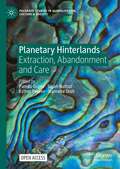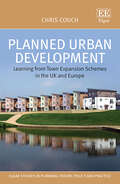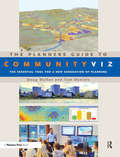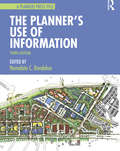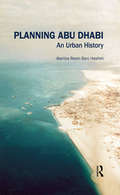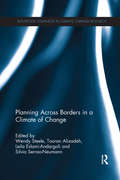- Table View
- List View
Planetary Hinterlands: Extraction, Abandonment and Care (Palgrave Studies in Globalization, Culture and Society)
by Pamila Gupta Sarah Nuttall Esther Peeren Hanneke StuitThis open access book considers the concept of the hinterland as a crucial tool for understanding the global and planetary present as a time defined by the lasting legacies of colonialism, increasing labor precarity under late capitalist regimes, and looming climate disasters. Traditionally seen to serve a (colonial) port or market town, the hinterland here becomes a lens to attend to the times and spaces shaped and experienced across the received categories of the urban, rural, wilderness or nature. In straddling these categories, the concept of the hinterland foregrounds the human and more-than-human lively processes and forms of care that go on even in sites defined by capitalist extraction and political abandonment. Bringing together scholars from the humanities and social sciences, the book rethinks hinterland materialities, affectivities, and ecologies across places and cultural imaginations, Global North and South, urban and rural, and land and water.
The Planetary Interest: A New Concept For The Global Age
by Kennedy GrahamThis text suggests that contemporary political and institutional arrangements for problem-solving, based on sovereignty as a principle and the nation-state as a decision-making unit, are not equipped to handle such problems and that concepts and methods of decision-making are therefore needed to augment existing ones in dealing with the challenges of the 21st-century.; Kennedy Graham argues that, henceforth, the planet and humanity must be considered as a single-entity for decsion making purposes. He introduces and develops the idea of the planetary interest as a vital conceptual tool to assist citizens and policy-makers in understanding emerging global problems and approaching them with global solutions. The book includes contributions from 20 current or former politicians, who discuss the particular global problems threatening their countries, looking at the ways in which the planetary interest can help them pursue a legitimate national interest.
The Planetary Interest
by Kennedy GrahamThis text suggests that contemporary political and institutional arrangements for problem-solving, based on sovereignty as a principle and the nation-state as a decision-making unit, are not equipped to handle such problems and that concepts and methods of decision-making are therefore needed to augment existing ones in dealing with the challenges of the 21st-century.; Kennedy Graham argues that, henceforth, the planet and humanity must be considered as a single-entity for decsion making purposes. He introduces and develops the idea of the planetary interest as a vital conceptual tool to assist citizens and policy-makers in understanding emerging global problems and approaching them with global solutions. The book includes contributions from 20 current or former politicians, who discuss the particular global problems threatening their countries, looking at the ways in which the planetary interest can help them pursue a legitimate national interest.
Planetary Justice: Stories and Studies of Action, Resistance and Solidarity
by Kuntala Lahiri-Dutt Jenia Mukherjee Yin Paradies Aditya Ghosh Kalyan Rudra Amrita Sen Anwesha Haldar Lakshminarayan Satpati Sharon Stein Marlies Kustatscher Anne Poelina Aleryk Fricker Natasha Abhayawickrama Alex Baird Robin A Bellingham Sanjana Dutt Souvik Lal Chakraborty Beth Christie Alicia Flynn Naomi Godden Lowell Hunter Callum McGregor Ruchira Talukdar Dani Villafaña Bill Webb Sandra Wooltorton Julian S. YatesAvailable open access digitally under CC-BY-NC-ND licence. Bringing together interdisciplinary climate change scholarship and grassroots activism, this book considers the possibilities of planetary justice across human difference, generations, species and the concept of life and non-life. Writing amidst bushfires, cyclones, global climate strikes and a global pandemic, contributors from the Earth Unbound Collective share stories from India, Australia, Canada and Scotland. Chapters draw on Indigenous, Black, Southern, ecosocialist and ecofeminist perspectives to call for more radical and interconnected ideas of justice and solidarity. This accessible book features diverse voices that speak with the planet in the face of climate change, biodiversity loss and extinction. It explores the politics and practices of working towards a future where the planet thrives.
Planetary Justice: Stories and Studies of Action, Resistance and Solidarity
by Kuntala Lahiri-Dutt Jenia Mukherjee Yin Paradies Aditya Ghosh Kalyan Rudra Amrita Sen Anwesha Haldar Lakshminarayan Satpati Sharon Stein Marlies Kustatscher Anne Poelina Aleryk Fricker Natasha Abhayawickrama Alex Baird Robin A Bellingham Sanjana Dutt Souvik Lal Chakraborty Beth Christie Alicia Flynn Naomi Godden Lowell Hunter Callum McGregor Ruchira Talukdar Dani Villafaña Bill Webb Sandra Wooltorton Julian S. YatesAvailable open access digitally under CC-BY-NC-ND licence. Bringing together interdisciplinary climate change scholarship and grassroots activism, this book considers the possibilities of planetary justice across human difference, generations, species and the concept of life and non-life. Writing amidst bushfires, cyclones, global climate strikes and a global pandemic, contributors from the Earth Unbound Collective share stories from India, Australia, Canada and Scotland. Chapters draw on Indigenous, Black, Southern, ecosocialist and ecofeminist perspectives to call for more radical and interconnected ideas of justice and solidarity. This accessible book features diverse voices that speak with the planet in the face of climate change, biodiversity loss and extinction. It explores the politics and practices of working towards a future where the planet thrives.
Planetary Politics: A Manifesto (Theory Redux)
by Lorenzo MarsiliThe global crisis of our time involves a complex of ecological, economic, technological and migratory challenges that no state is able to control. The result is a provincialisation of our democracies with respect to the new planetary powers confronting humanity. It is from this that our increasingly impotent and rabid politics stems. Paradoxical as it may seem, it is precisely the decline of the nation-state that is the source of the great nationalist uprising of our time.We need a new planetary vision that is able to reclaim and liberate our world, starting today and engaging each of us. This is the task of philosophy as much as it is of politics, of theory as it is of activism. Connecting with a new generation taking to the streets across the globe, this book tells the story of the ever-closer union of our world, from the age of empire to the climate crisis, and presents a plea and a roadmap to step beyond the mental and material boundaries of our nations.
Planned Urban Development: Learning from Town Expansion Schemes in the UK and Europe (Elgar Studies in Planning Theory, Policy and Practice)
by Chris CouchUsing case studies from the UK and Europe, Chris Couch examines the nature and achievements of the expanded towns programmes that emerged in the mid-20th century to accommodate population growth and overspill from densely populated urban areas. Thought-provoking insights into lessons to be learnt are provided, alongside arguments for further planned expansion of smaller towns today. This timely book investigates how development pressures caused by rapidly growing populations, have led to some disregard for health and housing standards, and how a fresh look at the relationship between urban form and public health is necessary, particularly in the wake of the Coronavirus pandemic. The author raises the importance of strong planning and public land acquisition, concluding with a strong case for a new programme of planned expansion in smaller towns. Written in an accessible style, this book is an excellent resource for students and researchers in urban planning, geography and history as well as housing policy, estate management and the built environment. Practitioners and policy makers within town planning and urban development would also find this an invaluable read.
A Planner's Encounter with Complexity (New Directions in Planning Theory)
by Gert de Roo Elisabete A. SilvaSpatial planning is about dealing with our 'everyday' environment. In A Planner's Encounter with Complexity we present various understandings of complexity and how the environment is considered accordingly. One of these considerations is the environment as subject to processes of continuous change, being either progressive or destructive, evolving non-linearly and alternating between stable and dynamic periods. If the environment that is subject to change is adaptive, self-organizing, robust and flexible in relation to this change, a process of evolution and co-evolution can be expected. This understanding of an evolving environment is not mainstream to every planner. However, in A Planner's Encounter with Complexity, we argue that environments confronted with discontinuous, non-linear evolving processes might be more real than the idea that an environment is simply a planner's creation. Above all, we argue that recognizing the 'complexity' of our environment offers an entirely new perspective on our world and our environment, on planning theory and practice, and on the raison d'être of the planners that we are. A Planner's Encounter with Complexity is organized into 17 chapters. It begins with the interplay of planning and complexity from the perspective of contemporary planning theory. It continues by critically assessing planning theory and practice in the light of the interdisciplinary debate regarding complexity thinking. As the book progresses, it positions itself ever closer to the perspective of complexity thinking, looking at the planning discipline 'from the outside in', clarifying the facets of complexity and its importance in planning. Finally, conceptual and theoretical developments towards more applied examples are identified in order to see the interplay of planning and complexity in practice. This book emphasizes the importance of complexity in planning, clarifies many of the concepts and theories, presents examples on planning and complexity, and proposes new ideas and methods for planning.
A Planner's Encounter with Complexity (New Directions in Planning Theory)
by Gert de Roo Elisabete A. SilvaSpatial planning is about dealing with our 'everyday' environment. In A Planner's Encounter with Complexity we present various understandings of complexity and how the environment is considered accordingly. One of these considerations is the environment as subject to processes of continuous change, being either progressive or destructive, evolving non-linearly and alternating between stable and dynamic periods. If the environment that is subject to change is adaptive, self-organizing, robust and flexible in relation to this change, a process of evolution and co-evolution can be expected. This understanding of an evolving environment is not mainstream to every planner. However, in A Planner's Encounter with Complexity, we argue that environments confronted with discontinuous, non-linear evolving processes might be more real than the idea that an environment is simply a planner's creation. Above all, we argue that recognizing the 'complexity' of our environment offers an entirely new perspective on our world and our environment, on planning theory and practice, and on the raison d'être of the planners that we are. A Planner's Encounter with Complexity is organized into 17 chapters. It begins with the interplay of planning and complexity from the perspective of contemporary planning theory. It continues by critically assessing planning theory and practice in the light of the interdisciplinary debate regarding complexity thinking. As the book progresses, it positions itself ever closer to the perspective of complexity thinking, looking at the planning discipline 'from the outside in', clarifying the facets of complexity and its importance in planning. Finally, conceptual and theoretical developments towards more applied examples are identified in order to see the interplay of planning and complexity in practice. This book emphasizes the importance of complexity in planning, clarifies many of the concepts and theories, presents examples on planning and complexity, and proposes new ideas and methods for planning.
Planner's Estimating Guide: Projecting Land-Use and Facility Needs
by Arthur NelsonThe United States faces enormous changes in the next 25 years. Arthur C. (Chris) Nelson starts this book with a few projections: The population will grow by one-third to 375 million. We will need 60 million new housing units to house these people. There will be 60 percent more jobs, requiring 50 billion additional square feet of nonresidential space. The bottom line is that half of all development in 2030 will have been built since 2000. Nelson estimates the cost of new construction alone to be at least $20 trillion. This book gives planning practitioners a powerful tool to help decide where to put this new development. It does not advocate one development scenario over another, but it revolutionizes the job of estimating land-use and facility needs. Planner's Estimating Guide offers easy-to-use formulas and worksheets that are formatted in an Excel workbook on CD-ROM and carefully explained in the text. They make it easy to figure future requirements for countless scenarios. The workbook and text deal with a 20-year planning horizon for a fictitious county, but both the time projection and scale are entirely adaptable to myriad local circumstances. The program allows you to gather a first impression of future land-use needs, and revise it to reflect local limitations. For example, if the landscape in question won't support the land-use estimations, change the assumptions in the workbook to devise new estimates. The workbook shows the implications of growth based on standard assumptions; you can change the assumptions as needed to reflect local conditions — including public input — to see how outcomes change. Use the workbook as a model for testing local sensitivities with respect to land supply constraints and changes in policy assumptions. The results won't tell you what to do, but will reveal the numerical implications of different scenarios. The book is written principally for practitioners, and also for planning students as a primary or supplementary text. Used creatively, the powerful tools in Planner's Estimating Guide will help you determine the numerical implications of an almost infinite number of future circumstances that may affect your community.
Planner's Estimating Guide: Projecting Land-Use and Facility Needs
by Arthur NelsonThe United States faces enormous changes in the next 25 years. Arthur C. (Chris) Nelson starts this book with a few projections: The population will grow by one-third to 375 million. We will need 60 million new housing units to house these people. There will be 60 percent more jobs, requiring 50 billion additional square feet of nonresidential space. The bottom line is that half of all development in 2030 will have been built since 2000. Nelson estimates the cost of new construction alone to be at least $20 trillion. This book gives planning practitioners a powerful tool to help decide where to put this new development. It does not advocate one development scenario over another, but it revolutionizes the job of estimating land-use and facility needs. Planner's Estimating Guide offers easy-to-use formulas and worksheets that are formatted in an Excel workbook on CD-ROM and carefully explained in the text. They make it easy to figure future requirements for countless scenarios. The workbook and text deal with a 20-year planning horizon for a fictitious county, but both the time projection and scale are entirely adaptable to myriad local circumstances. The program allows you to gather a first impression of future land-use needs, and revise it to reflect local limitations. For example, if the landscape in question won't support the land-use estimations, change the assumptions in the workbook to devise new estimates. The workbook shows the implications of growth based on standard assumptions; you can change the assumptions as needed to reflect local conditions — including public input — to see how outcomes change. Use the workbook as a model for testing local sensitivities with respect to land supply constraints and changes in policy assumptions. The results won't tell you what to do, but will reveal the numerical implications of different scenarios. The book is written principally for practitioners, and also for planning students as a primary or supplementary text. Used creatively, the powerful tools in Planner's Estimating Guide will help you determine the numerical implications of an almost infinite number of future circumstances that may affect your community.
The Planners Guide to CommunityViz: The Essential Tool for a New Generation of Planning
by Doug WalkerWhat does the future look like? Planners wrestle with this question daily as they strive to bring a community's vision of itself to life, in all its complexity. Here is an authoritative and accessible guide to a tool that combines 3-D visualization, data analysis and scenario building to let planners and citizens see the future impacts of a plan or development. The Planners Guide to CommunityViz is the first book to explain how to support planning projects with CommunityViz, GIS-based software that planners around the world are using to help decision-makers, professionals, and the public visualize, analyze, and communicate about development proposals, future growth patterns, and the outcome of particular plans or developments. It shows the planner which tools and techniques to use and how to use them for maximum effectiveness on planning projects large and small. Full of practical examples and case studies, the book shows how CommunityViz can enliven the comprehensive planning process from visioning, to public participation, to values mapping, to build-out analysis. Chapters show how to use CommunityViz to analyze zoning regulations, calculate the costs of community services, and evaluate development proposals requiring design review. In addition, it is applicable to transportation planning, natural-resource planning, land-development suitability assessment, and urban economic development analysis.
The Planners Guide to CommunityViz: The Essential Tool for a New Generation of Planning
by Doug WalkerWhat does the future look like? Planners wrestle with this question daily as they strive to bring a community's vision of itself to life, in all its complexity. Here is an authoritative and accessible guide to a tool that combines 3-D visualization, data analysis and scenario building to let planners and citizens see the future impacts of a plan or development. The Planners Guide to CommunityViz is the first book to explain how to support planning projects with CommunityViz, GIS-based software that planners around the world are using to help decision-makers, professionals, and the public visualize, analyze, and communicate about development proposals, future growth patterns, and the outcome of particular plans or developments. It shows the planner which tools and techniques to use and how to use them for maximum effectiveness on planning projects large and small. Full of practical examples and case studies, the book shows how CommunityViz can enliven the comprehensive planning process from visioning, to public participation, to values mapping, to build-out analysis. Chapters show how to use CommunityViz to analyze zoning regulations, calculate the costs of community services, and evaluate development proposals requiring design review. In addition, it is applicable to transportation planning, natural-resource planning, land-development suitability assessment, and urban economic development analysis.
Planners in Politics: Do they Make a Difference? (PDF) (Elgar Studies in Planning Theory, Policy and Practice)
by Louis AlbrechtsIn this innovative book, ten executive politicians with backgrounds in planning from around the world dissect their own political careers. Reflecting on the often structural impact of their work in political decision-making, they also consider the translation of their experiences back into academic life or professional practice. These revealing stories illustrate the vital role of planners in politics. Specific examples show how they were able to make a difference during their tenure by defining problems, setting agendas, using different catalyst for change and raising awareness of issues around sustainability, equity, social justice, poverty and power. Drawing on these experiences to argue for innovative pedagogies and practices in planning, this book illuminates the frequently invisible work of planners in politics, the benefits of their training and education, and the wisdom that they can offer theorists, students and practitioners about transformative planning. This book will be critical reading for researchers and students of spatial planning, urban geography and politics. Urban planners and politicians will also benefit from these insights into the political experience of planning.
The Planner's Use of Information
by Hemalata C. DandekarFor more than 35 years, planners have depended on The Planner's Use of Information to help them address their information needs. While the ability to manage complex information skillfully remains central to the practice of planning, the variety and quantity of information have ballooned in the last two decades. The methods of accessing and handling information– although often ultimately easier and faster– require new technical savvy. At the same time, planners themselves, and the constituents they serve, have changed. This completely revised and updated third edition of this popular book will serve the new generation of planners who work in a world where social media, cell phones, community embedded development, and a changing population have revolutionized the practice of planning. Edited again by Hemalata C. Dandekar, with chapters by leading experts in data collection, analysis, presentation, and management, The Planner's Use of Information empowers practitioners to use and address the impacts of twenty-first century technologies. The Planner's Use of Information offers a range of methods for addressing many kinds of information needs in myriad situations. It's an invaluable day-to-day resource for practicing planners and an ideal classroom text for courses in planning communication and analytical methods. Illustrations, real-life examples, cartoons, exercises, bibliographies, and lists of online resources enrich the text.
The Planner’s Use of Information; Third Edition
by Hemalata C. DandekarFor more than 35 years, planners have depended on The Planner’s Use of Information to help them address their information needs. While the ability to manage complex information skillfully remains central to the practice of planning, the variety and quantity of information have ballooned in the last two decades. The methods of accessing and handling information—although often ultimately easier and faster—require new technical savvy. At the same time, planners themselves, and the constituents they serve, have changed. This completely revised and updated third edition of this popular book will serve the new generation of planners who work in a world where social media, cell phones, community-embedded development, and a changing population have revolutionized the practice of planning. Edited again by Hemalata C. Dandekar, with chapters by leading experts in data collection, analysis, presentation, and management, The Planner’s Use of Information empowers practitioners to use and address the impacts of twenty-first-century technologies. The book offers a range of methods for addressing many kinds of information needs in myriad situations. It is an invaluable day-to-day resource for practicing planners and an ideal classroom text for courses in planning communication and analytical methods. Illustrations, real-life examples, cartoons, exercises, bibliographies, and lists of online resources enrich the text.
Planning: Buildings for Habitation, Commerce and Industry
by Edward D. MillsPlanning: Buildings for Habitation, Commerce, and Industry focuses on the planning, design, materials, and construction of various structures for habitation. The selection first discusses the planning, construction, and design of houses, flats, and residential hostels. The discussions focus on siting, planning, space conditions, statutory requirements legislation and authorities, heating and water supply, common rooms, and accommodation. The manuscript also takes a look at planning, construction, and design of hotels, motels, and camps for motorists. The book reviews the construction, planning, materials, and design of office buildings and banks, including characteristics of buildings, types of accommodation, furnishing, and materials and equipment. The text also ponders on the design, planning, and construction of department stores, supermarkets, shops, farm and agricultural buildings, factories, airports, and warehouses. The selection is a dependable source of reference for readers and construction planning specialists interested in the planning, design, and construction of buildings.
Planning Abu Dhabi: An Urban History (Planning, History and Environment Series)
by Alamira Reem Bani HashimAbu Dhabi’s urban development path contrasts sharply with its exuberant neighbour, Dubai. As Alamira Reem puts it, Abu Dhabi, capital of the United Arab Emirates since 1971, ‘has been quietly devising its own plans … to manifest its role and stature as a capital city’. Alamira Reem, a native Abu Dhabian and urban planner and researcher who has studied the emirate’s development for more than a decade, is uniquely placed to write its urban history. Following the introduction and description of Abu Dhabi’s early modern history, she focuses on three distinct periods dating from the discovery of oil in 1960, and coinciding with periods in power of the three rulers since then: Sheikh Shakhbut bin Sultan Al Nahyan (1960–1966), Sheikh Zayed bin Sultan Al Nahyan (1966–2004), and Sheikh Khalifa bin Zayed Al Nahyan (2004–). Based on archival research, key interviews and spatial mapping, she analyses the different approaches of each ruler to development; investigates the role of planning consultants, architects, developers, construction companies and government agencies; examines the emergence of comprehensive development plans and the policies underlying them; and assesses the effects of these many and varied influences on Abu Dhabi’s development. She concludes that, while much still needs to be done, Abu Dhabi’s progress towards becoming a global, sustainable city provides lessons for cities elsewhere.
Planning Abu Dhabi: An Urban History (Planning, History and Environment Series)
by Alamira Reem Bani HashimAbu Dhabi’s urban development path contrasts sharply with its exuberant neighbour, Dubai. As Alamira Reem puts it, Abu Dhabi, capital of the United Arab Emirates since 1971, ‘has been quietly devising its own plans … to manifest its role and stature as a capital city’. Alamira Reem, a native Abu Dhabian and urban planner and researcher who has studied the emirate’s development for more than a decade, is uniquely placed to write its urban history. Following the introduction and description of Abu Dhabi’s early modern history, she focuses on three distinct periods dating from the discovery of oil in 1960, and coinciding with periods in power of the three rulers since then: Sheikh Shakhbut bin Sultan Al Nahyan (1960–1966), Sheikh Zayed bin Sultan Al Nahyan (1966–2004), and Sheikh Khalifa bin Zayed Al Nahyan (2004–). Based on archival research, key interviews and spatial mapping, she analyses the different approaches of each ruler to development; investigates the role of planning consultants, architects, developers, construction companies and government agencies; examines the emergence of comprehensive development plans and the policies underlying them; and assesses the effects of these many and varied influences on Abu Dhabi’s development. She concludes that, while much still needs to be done, Abu Dhabi’s progress towards becoming a global, sustainable city provides lessons for cities elsewhere.
Planning Across Borders in a Climate of Change (Routledge Advances in Climate Change Research)
by Wendy Steele Tooran Alizadeh Leila Eslami-Andargoli Silvia Serrao-NeumannThe fixity or mobility of borders are key themes within the border studies literature and have useful critical application to urban and environmental planning through theory, pedagogy and practice. This offers potential for transformative change through the processes of re-bordering and re-orienting established boundary demarcations in ways that support and promote sustainability in a climate of change. Planning Across Borders in a Climate of Change draws on a range of diverse case studies from Australasia, North and South America, Europe, Africa, the Middle East and Asia and offers the application of border theory, concepts and principles to planning as a critical lens. It applies this lens to a range of international case studies in key areas such as climate change adaptation, food security, spatial planning, critical infrastructure and urban ecology. This collection fills an important gap in the border studies literature, bringing climate change considerations to bear on planning. It should be of interest to students, scholars and professionals in the field of urban and environmental planning, climate change adaptation, border studies, urban studies, human and political geography, environmental studies and development.
Planning Across Borders in a Climate of Change (Routledge Advances in Climate Change Research)
by Wendy Steele, Tooran Alizadeh, Leila Eslami-Andargoli and Silvia Serrao-NeumannThe fixity or mobility of borders are key themes within the border studies literature and have useful critical application to urban and environmental planning through theory, pedagogy and practice. This offers potential for transformative change through the processes of re-bordering and re-orienting established boundary demarcations in ways that support and promote sustainability in a climate of change. Planning Across Borders in a Climate of Change draws on a range of diverse case studies from Australasia, North and South America, Europe, Africa, the Middle East and Asia and offers the application of border theory, concepts and principles to planning as a critical lens. It applies this lens to a range of international case studies in key areas such as climate change adaptation, food security, spatial planning, critical infrastructure and urban ecology. This collection fills an important gap in the border studies literature, bringing climate change considerations to bear on planning. It should be of interest to students, scholars and professionals in the field of urban and environmental planning, climate change adaptation, border studies, urban studies, human and political geography, environmental studies and development.
Planning After Petroleum: Preparing Cities for the Age Beyond Oil
by Neil Sipe Jago Dodson Anitra NelsonThe past decade has been one of the most volatile periods in global petroleum markets in living memory, and future oil supply security and price levels remain highly uncertain. This poses many questions for the professional activities of planners and urbanists because contemporary cities are highly dependent on petroleum as a transport fuel. How will oil dependent cities respond, and adapt to, the changing pattern of petroleum supplies? What key strategies should planners and policy makers implement in petroleum vulnerable cities to address the challenges of moving beyond oil? How might a shift away from petroleum provide opportunities to improve or remake cities for the economic, social and environmental imperatives of twenty-first-century sustainability? Such questions are the focus of contributors to this book with perspectives ranging across the planning challenge: overarching petroleum futures, governance, transition and climate change questions, the role of various urban transport nodes and household responses, ways of measuring oil vulnerability, and the effects on telecommunications, ports and other urban infrastructure. This comprehensive volume – with contributions from and focusing on cities in Australia, the UK, the US, France, Germany, the Netherlands and South Korea – provides key insights to enable cities to plan for the age beyond petroleum.
Planning After Petroleum: Preparing Cities for the Age Beyond Oil
by Neil Sipe Jago Dodson Anitra NelsonThe past decade has been one of the most volatile periods in global petroleum markets in living memory, and future oil supply security and price levels remain highly uncertain. This poses many questions for the professional activities of planners and urbanists because contemporary cities are highly dependent on petroleum as a transport fuel. How will oil dependent cities respond, and adapt to, the changing pattern of petroleum supplies? What key strategies should planners and policy makers implement in petroleum vulnerable cities to address the challenges of moving beyond oil? How might a shift away from petroleum provide opportunities to improve or remake cities for the economic, social and environmental imperatives of twenty-first-century sustainability? Such questions are the focus of contributors to this book with perspectives ranging across the planning challenge: overarching petroleum futures, governance, transition and climate change questions, the role of various urban transport nodes and household responses, ways of measuring oil vulnerability, and the effects on telecommunications, ports and other urban infrastructure. This comprehensive volume – with contributions from and focusing on cities in Australia, the UK, the US, France, Germany, the Netherlands and South Korea – provides key insights to enable cities to plan for the age beyond petroleum.
Planning Against the Political: Democratic Deficits in European Territorial Governance
by Philip Allmendinger Jonathan Metzger Stijn OosterlynckThis book brings together a number of highly innovative and thought provoking contributions from European researchers in territorial governance-related fields such as human geography, planning studies, sociology, and management studies. The contributions share the ambition of highlighting troubling contemporary tendencies where spatial planning and territorial governance can be seen to circumscribe or subvert ‘due democratic practice’ and the democratic ethos. The book also functions as an introduction to some of the central strands of contemporary political philosophy, discussing their relevance for the wider field of planning studies and the development of new planning practices.
Planning Against the Political: Democratic Deficits in European Territorial Governance
by Jonathan Metzger Philip Allmendinger Stijn OosterlynckThis book brings together a number of highly innovative and thought provoking contributions from European researchers in territorial governance-related fields such as human geography, planning studies, sociology, and management studies. The contributions share the ambition of highlighting troubling contemporary tendencies where spatial planning and territorial governance can be seen to circumscribe or subvert ‘due democratic practice’ and the democratic ethos. The book also functions as an introduction to some of the central strands of contemporary political philosophy, discussing their relevance for the wider field of planning studies and the development of new planning practices.
